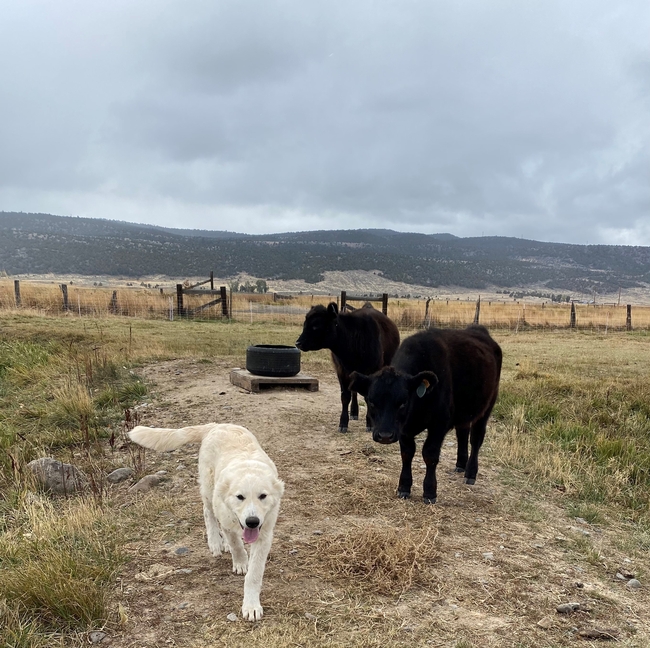Bonding works both ways...
Bonding a livestock guardian dog (LGD) to livestock is a critical first step in using dogs to protect livestock from predators. Practically, the bonding process helps ensure that the dog will stay with livestock; economically, successful bonding improves the cost effectiveness of this tool. But as I've learned in bonding my own LGDs with our sheep, the bonding process has to work in both directions. The dog must be bonded to the livestock, obviously; naïve livestock take some time to bond to the dog, as well. We're learning this lesson again as we're bonding Sam the LGD pup with cattle in Likely, CA.
Several weeks ago, our rancher-collaborator, Myles Flournoy, needed to work some calves – and decided to work the seven orphaned calves that had been bonding with Sam. Myles had some smaller orphaned calves that he intended to replace them with; figuring a new set of calves would be helpful in Sam's progress. I would have figured the same thing.
These new calves had been around herding dogs, but never a 50+ pound goofball of a puppy. Sam was excited to meet his new “friends.” The calves, unfortunately didn't share his enthusiasm. Myles reported that Sam clumsily bounded up to the calves – and proceeded to push them through the electric fence, leaving Sam sitting next to the now flattened electro-net! The new calves had not been exposed to electric fence, nor had they been fed grain (as the first calves had been) – these new experiences made the transition even more challenging. Myles sorted off two of the original calves and added them back to the pasture – they were happy to see Sam! Myles reported that it took more than two weeks of uncertainty, but by the time I visited the ranch on October 13, the new calves had settled down, as well. And the bonding process continues.
I've noticed a similar dynamic when I've purchased sheep that have not been with an LGD. The naïve sheep are typically afraid of the dogs – probably because all of their prior interactions with dogs have been with herding dogs or with dogs that are chasing them for sport. I've found if we combine the new sheep with our own ewes (who know and trust our LGDs), they settle down quickly.
Ranchers who use LGDs with cattle report comparable observations. Cat Urbigkit, a Wyoming sheep and cattle rancher who uses LGDs extensively, tells me that she will introduce dogs to uninitiated cattle along with two or three steers or heifers that are well-used to the LGDs. Having cattle that trust the dogs seems to calm the new cattle more quickly. Jill Hackett, who runs a cow-calf and sheep operation in Humboldt County, says it took about 6 months for her cattle to completely bond to the dogs. Anna Harvey, who ranches in Sierra Valley, says it took longer than that initially, but now that there are cows in her herd who are used to the dogs, it only takes two days for the new cattle to become comfortable with the LGDs.
In observing our sheep with our dogs – and in observing Sam with his calves yesterday – this reciprocal bonding becomes evident. Some of our sheep will actively seek the dogs when they bed down. Myles reported that when he returned the two original calves the pasture, they walked over and nuzzled Sam (a phenomenon I observed yesterday, as well). The benefit of this reciprocal bonding has practical implications beyond keeping livestock and dogs together. A research project at the U.S. Sheep Experiment Station in Dubois, ID, found that ewes and lambs grazing in the company of an LGD traveled greater distances: “Our findings support the hypothesis that sheep with LGDs spend less time being vigilant for predators and more time moving,” the researchers reported, adding “As a result of traveling greater distances, ewes may also be exposed to more and varied foraging opportunities. The observed changes in movement behavior may result in more effective use of pasture resources” (Webber, B. et. al 2015 - read the abstract here).
Sam still has a long road ahead of him – he is still a puppy, after all! But I am impressed with the progress he's made – and with the progress the calves are making. And once again, we are incredibly thankful for the work that Myles and the entire Likely Land and Livestock crew are putting into this effort! Stay tuned!
